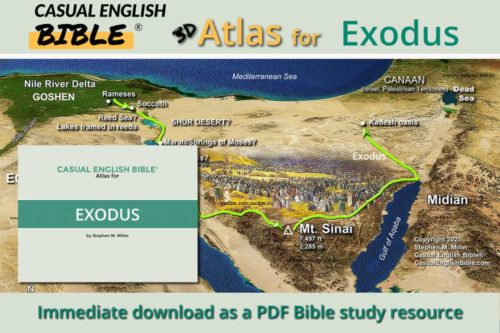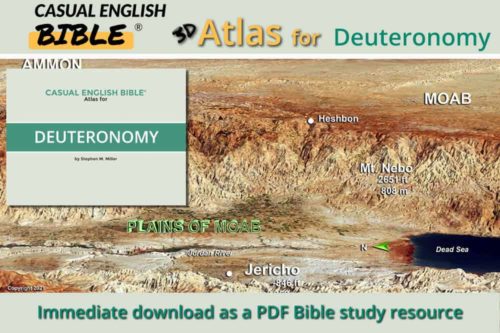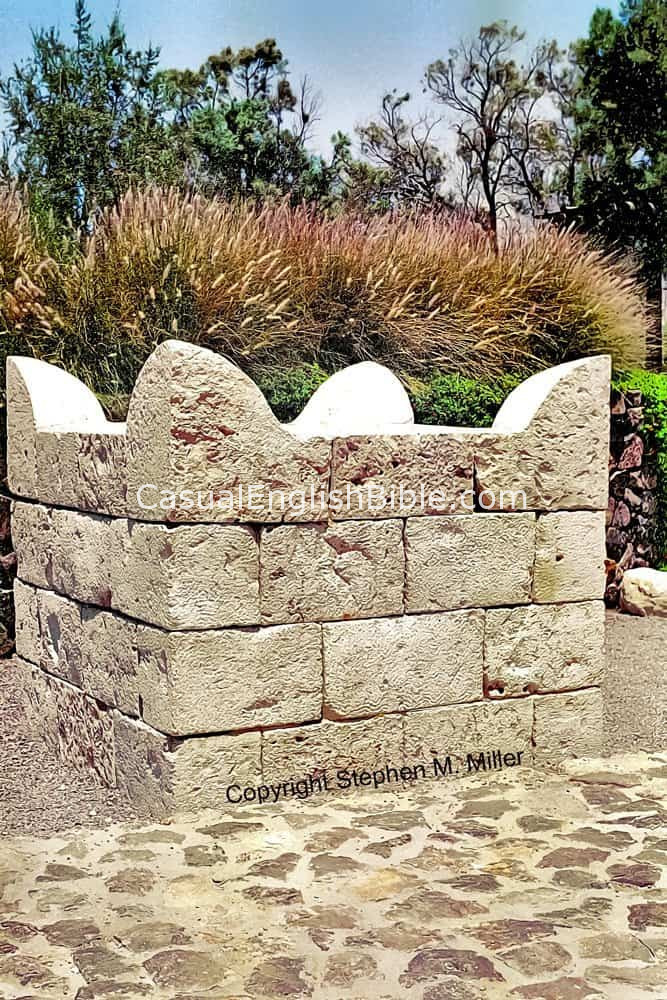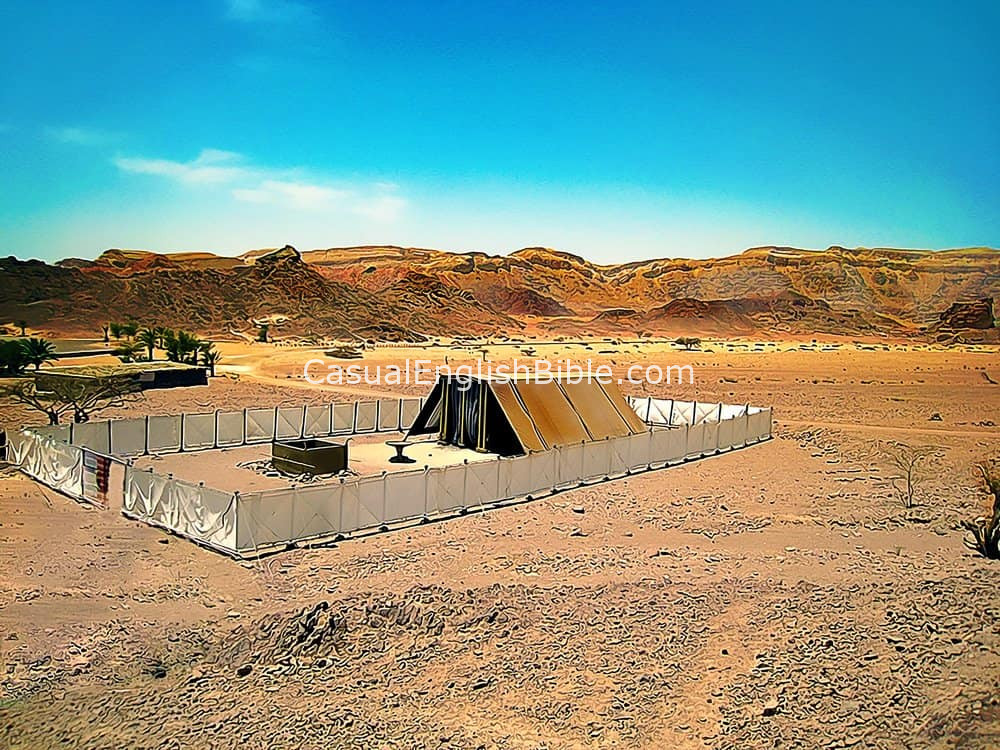Exodus 27
Finishing the worship center
Building the altar to sacrifice animals
1Make a sacrificial altar out of acacia wood. Shape it into a square that is 7 ½ feet wide and long, and 4 ½ feet high (2.3 m x 1.5 m). 2Shape each of the four corners into what looks like an animal horn. [1] Don’t make these horns separately and then attach them to the altar later. Instead, build them right into the altar as one unit. Cover the wooden altar with a layer of bronze. 3Use bronze, also, to make the utensils you’ll need when you burn sacrificial animals on the altar. These include fire pans to carry hot coals to start the fire, forks to position the sacrifice on the altar, bowls used in sprinkling rituals, shovels to scoop up the ashes, and buckets to haul the ashes away.4Make a bronze grating [2] for the altar. Add a bronze ring to each of the four corners. 5Put the grating below the rim of the altar and extend it halfway down the altar. 6Make poles to carry the altar. Make the poles out of acacia wood and cover them with bronze. 7To carry the altar, put the poles into rings attached to the altar. There will be one pole on each side of the altar. 8Build the altar hollow as I showed you on the mountain.
Courtyard of worship center
9Make a courtyard for the worship center, and surround it with a wall of curtains made from the finest linen. Curtains on the south side of the courtyard should stretch 50 yards (46 m) long. 10Support the curtains with 20 bronze posts and bases. Hang the curtains from silver rods and hooks. 11Do the same for the 50 yards of curtains running along the north side of the courtyard. Support the curtains with 20 bronze posts and bases. Hang the curtains from silver rods and hooks, as before. 12Make the courtyard 25 yards (23 m) wide on the west side. Support the curtains with 10 posts and bases.13Make the courtyard on the east side 25 yards (23 m) wide, also. 14The east side of the courtyard will become the eastern gate, the courtyard entrance. It will have two curtains, one on each side of the entrance. The curtain on the right will stretch 7 1/2 yards long (almost 7 m), supported by three posts and bases. 15Curtains on the left side of the entrance will also reach 7 1/2 yards long, supported by three posts and bases. 16Make the entrance gate out of the curtain that stretches 10 yards (9 m) across. Have a weaver make it out of the finest linen, embroidered with decorations in blue, purple, and crimson. Support this curtain with four posts and bases. 17Make sure that all the posts in the courtyard are seated in bronze bases and are equipped with silver rings and hooks.
18The footprint of the entire courtyard will reach 50 yards long and 25 yards wide (46 m x 23 m). Curtains of fine linen 7 1/2 feet (2 1/2 m) high will surround it. These curtains are supported by bronze posts and bases. 19Use bronze to make any other utensils or equipment you need for the worship center. Make the tent pegs out of bronze, too.
Keep the holy lights burning
20Tell the people of Israel to bring you their purest olive oil, from the first pressing. [3] Use it to keep the light burning. 21The lamp in the sanctuary will provide the light. Place the lampstand in front of the curtain that separates the Sacred Room from the Most Sacred Room, which holds the box that contains the Ten Commandments. Aaron and his sons are responsible for keeping the light burning all night, every night. Continue doing this in the years to come, from one generation to the next.”Footnotes
Archaeologists have uncovered many “horned altars” in Israel and Palestinian Territories. Bible writers never explained why altars were built with the corners turned up like animal horns. Perhaps the horns were a tribute to the livestock sacrificed on the altar. One more common guess is that the horns gave priests something to which they could tie the dead animal. This could help keep the sacrificed animal from rolling off the fire before it was burned. Psalm 118:27 seems to add credibility to that theory: “Go ahead and tie the festival sacrifice to the four corners of the altar.” Consider how it might feel for a worshiper to watch the sacrificed animal roll off the flaming altar before the animal had even caught fire. We might understand that the animal fell off because the burning wood pile shifted as wood disintegrated in the fire. But someone offering a sacrifice to seek forgiveness for sin might think God had just rejected the offering.
The writer’s description of the grating isn’t complete enough to give us an accurate picture of what the altar grating looked like or why it was there. Scholars are left guessing, which many of them seem to love to do. Some scholars say the writer was describing decorative grating around the bottom half of the altar—a bit like wainscoting with bronze. Others picture the altar a little like a deck sitting above an area with lattice fencing below the deck. The lattice was to the deck what the grating was to the altar. Others describe the grading as the kind of thing barbecue aficionados would understand: the grating of a barbecue grill. Still others note that Exodus 27:8 says the altar was hollow. So they speculate that the grating was a metal strainer placed inside the altar, looking a bit like the strainer in which French fries are dipped into hot oil. This strainer inside the altar would allow ashes and grease from animal fat to fall to the ground. It would also have helped create a draft to fuel the fire. In addition, the metal framing would have reinforced the structure of the wooden altar, making it stronger. A full-grown dead bull can weight a ton (about 900 kg) or more.
Olive farmers crushed their olives more than once for the oil inside them. The first crushing produced the best and most expensive oil. Later crushing added some pulp sediment from the olives, which made the oil less pure. So, it was cheaper. God told the people of Israel to use only the finest olive oil to light the inside of the worship center. Yet only the priests would see this light. Only they could go inside the tent, and later, the Jerusalem Temple sanctuary. All other people of Israel had to stay outside, in the courtyard.
Discussion Questions
- Sorry, there are currently no questions for this chapter.








